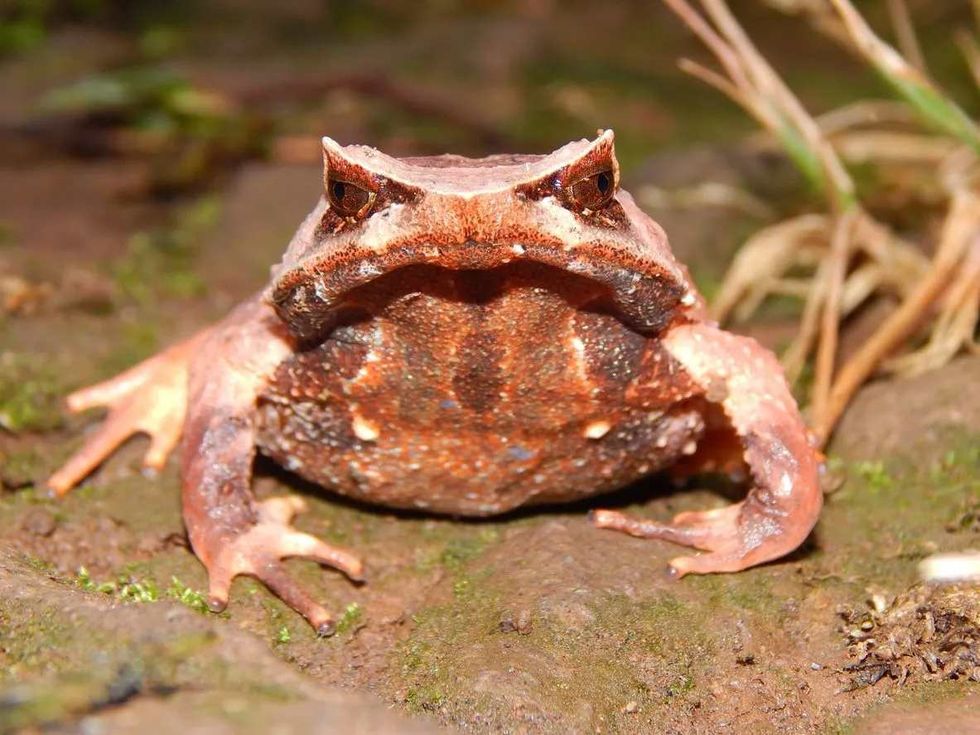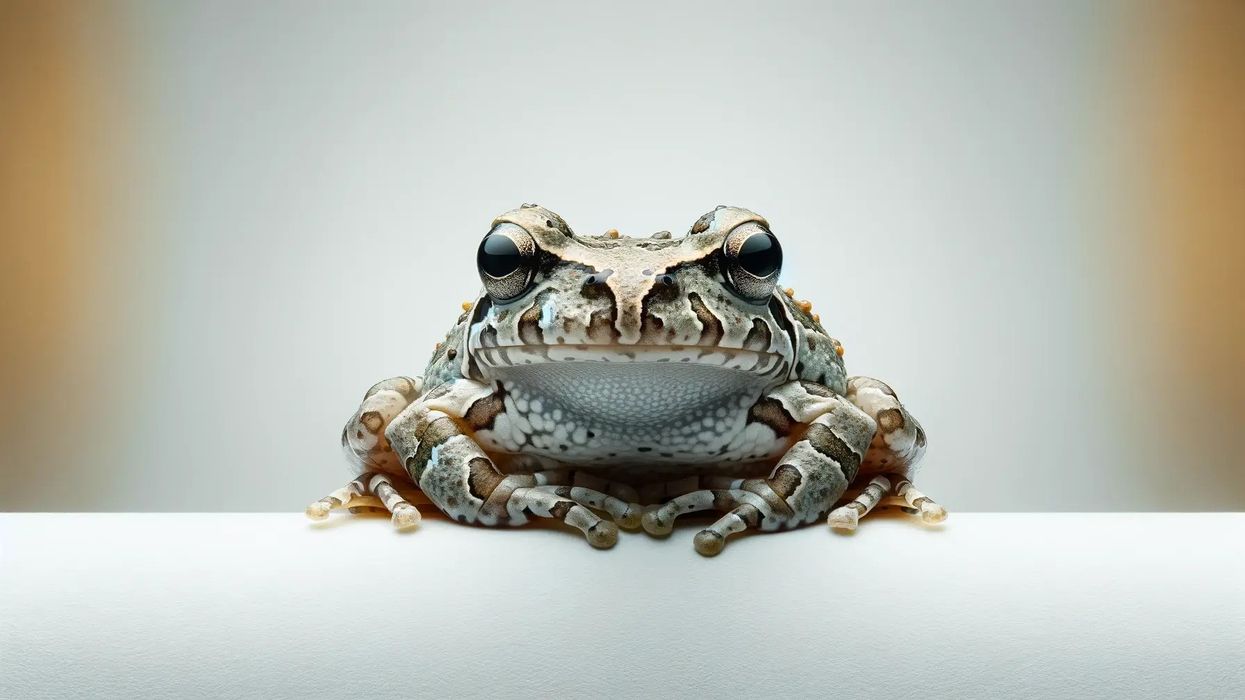The Horned frog is known by various names, including the Argentine wide-mouthed frog, Pacman frog, Ornate Horned frog, and Bell's Horned frog. These frogs stand out with their horn-like eyes and wide mouth by way of appearance.
Horned frogs bury under the leaves of the forest, looking for prey with their head exposed. Interestingly, their peculiar build also helps them in this camouflage.
They pounce on anything that walks by them, and as they are not picky with their diet, they gain excess weight by eating anything that comes their way. However, this camouflage doesn't always help them from their predators that include snakes and birds.
The Horned frog (Ceratophrys ornata) is currently listed as Near Threatened as per the International Union for Conservation of Nature, considering it is closer to extinction in the near future. Read on to learn more about these amphibians before it's too late!
If you enjoy reading Texas Horned frog facts, then check out some more interesting facts on the marine toad and tree frog.
Horned Frog Interesting Facts
What type of animal is a Horned Frog?
Argentine Horned frogs are amphibians from the genus name Ceratophrys and the family Ceratophryidae. The scientific name of these species is Ceratophrys ornata, and they are known to be vertebrate animals who spend at least part of their life cycle in water.
What class of animal does a Horned Frog belong to?
Horned frogs belong to the class Amphibia, a class that comprises the frogs, newts, toads, caecilians, and salamanders. They are distinguished by their ability to breathe through gills in water and with the lungs on land.
How many Horned Frogs are there in the world?
There are no specifics in numbers on how many of these animals are left in the world. However, like all amphibians, these species are severely affected by environmental changes and pollution because of their delicate skin. It is currently believed that their population is reduced to 50% compared to their historical numbers.
Where does a Horned Frog live?
These animals are only found in South America, from Colombia to Brazil, and throughout the Amazon Basin. They can also be found in the grasslands of Uruguay and Argentina.
What is a Horned Frog's habitat?
Horned frogs prefer wet, humid tropical rainforests with leafy muddy floors. They commonly make their home in temporary water bodies. They may also reside near an irrigated cropland and roadside ditches made by humans if possible.
Who do Horned Frogs live with?
The Surinam Horned frog is a solitary creature, highly territorial, and prefers to live alone near small water tanks. They will defend their territories very fiercely and eat their species; hence, if you plan to keep them as pets, it's best not to keep them all together in one enclosure.
How long does a Horned Frog live?
The average lifespan of this frog is six to seven years. They are known to survive longer for up to 10-15 years in captivity.
How do they reproduce?
The Pacman frog (Ceratophrys ornata) is believed to reach sexual maturity between 18-24 months of age. Male frogs produce loud calls to attract female frogs, and they breed in small pools of water during the rainy season in the late spring.
They lay up to 1,000-1,500 eggs per season upon successful fertilization, and females wrap these eggs around aquatic plants until they hatch, which usually takes about 3-25 days.
What is their conservation status?
Horned frogs are vulnerable, close to finding a place on the endangered species list, and currently listed as Near Threatened. Although there is a lack of population count of these animals currently, there is evidence that their population is declining.
This decrease can be attributed to losing their food source, captive-bred specimens as a part of the pet trade, and habitat destruction for agricultural uses.
Horned Frog Fun Facts
What do Horned Frogs look like?
This animal has a roundish body, stubby limbs, with bumpy skin. One peculiar feature of this frog is that its jaw is as wide as its head. Males have dark-bearded throats, and females have no beard.
They generally come in different colors, such as beige, yellow, green, brown, and red, on their limbs and black with light yellow or white on the undersides. Owing to their short legs, they are particularly good at jumping. This species is recognizable for its horn-like eyes too.
How cute are they?
This amphibian is not famous for its cuteness but is indeed an attention seeker for its wide jaws and the way the eyes are projected. For this reason, these frogs are kept as exotic pets.
How do they communicate?
The Horned frogs use different sounds to communicate. Even tadpoles can make distress calls three days after they are born. This is one of the notable features as this is the only well-known example of young vertebrates making such calls.
How big is a Horned Frog?
This amphibian stands out because of its size; it can grow up to 8 in (20 cm), covering an average tea saucer. Female frogs can grow to a larger than males. An average female can be up to 6.5 in (16.5 cm), while a male can reach up to 4.5 in (11.4 cm).
How fast can a Horned Frog run?
Just like all frogs, they hop and jump around rather than running. Due to the short limbs, they are not great at jumping.
How much does a Horned Frog weigh?
Adult frogs can reach a little over one pound, but they are more commonly half a pound on average. Females are almost double in size than their male counterparts.
What are their male and female names of the species?
This amphibian has no specific name for their female and male species. Physically, there are some differences in terms of color and size. Usually, females usually larger than males.
What would you call a baby Horned Frog?
Young frogs are referred to as babies, tadpoles, and juveniles, depending on their growth stage.
What do they eat?
In the forest, the Horned frogs' diet includes small mice, reptiles, insects, spiders, among other small wild creatures. Their ability to swallow anything, even if the prey is of their own size, adds to their reputation. For this reason, they are also known to suffocate prey while catching it, but they are also highly voracious.
Are they dangerous?
The Horned frog (Ceratophrys ornata) is an 'observation' pet. They are best not handled with bare hands because they tend to bite.
Being kept in isolation is well suited to them as they are also not very compatible with others. Horned frogs can shoot out blood confusing their predators in the wild; this blood contains toxins that can be life-threatening to its predators like wolves, coyotes, and dogs. Sometimes, these animals are killed mistakenly because of this behavior.
Would they make a good pet?
Mostly prone to the pet trade, this amphibian makes a good choice for a beginner looking to keep an exotic pet frog. It adjusts well in captivity with fresh water at all times.
They are prone to infection if there is no clean water or temperature regulation in their enclosure, and this may even lead to death. This animal has to be kept alone, including juveniles and babies, in their enclosure as they are very territorial.
Their diet is also fairly simple to manage; juveniles can be fed crickets, small mice, and small goldfish. Similarly, adult frogs' diet may include giant goldfish, rats, and mice.
Did you know...
If you have to draw this frog, it is a straightforward exercise; first, draw a big arc that is shorter on one side than the other, draw a slight curve towards the inside on the shorter side, and then join it to the longer side with a slightly rounded bottom.
On the highest side of its head, draw two small circles for the eye and keep inverted cones for horns above them.
From the farthest point of the frogs, mouth, draw a big frown that doesn't quite go down all the way but covers almost 70% of the face representing its mouth and then adds small limbs, and it is done.
Naming the Horned Frog
The Horned frog's name is inspired by the horn-like projections above a frog's eyes that resemble horns. These 'horns' are ideal for providing camouflage on the forest floor.
Different types of Horned Frog
Primarily, there are eight different types of Horned frog species. They are Cranwell's Horned frog, Argentine Horned frog, Surinam Horned frog, Brazilian Horned frog, Pacific Horned frog, Venezuelan Horned frog, Caatinga Horned frog, and Ecuadorian Horned frog. They are all commonly known as South American Horned frogs.
The most notable differentiator among these different types is their color, and they also come in different sizes. There is also the obvious difference of where you might find them, i.e. the Surinam Horned frog will be found in Surinam.
Here at Kidadl, we have carefully created lots of interesting family-friendly animal facts for everyone to discover! Learn more about some other amphibians including pool frog, or caecilian.
You can even occupy yourself at home by drawing one on our Horned frog coloring pages.










